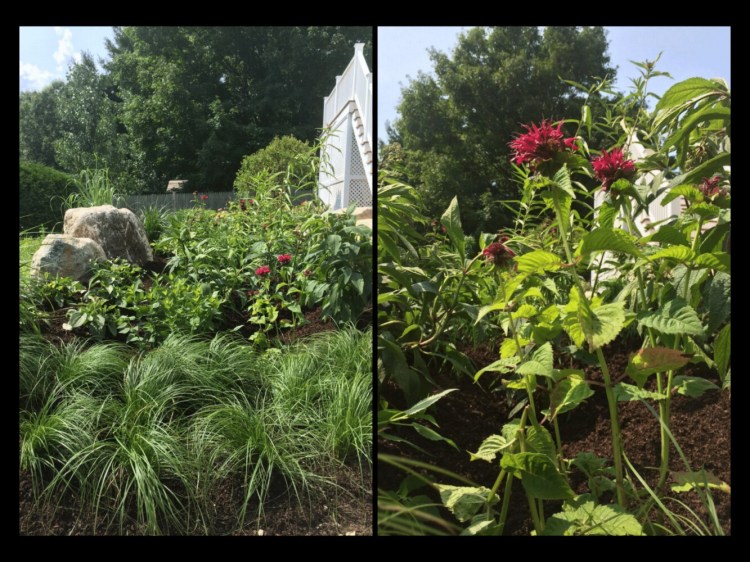It goes without saying that water is necessary for gardening. But too much water – or too little – can also be a problem.
Overall, the Northeast is getting wetter, although it might not seem that way, with the number of long dry spells, if not droughts, we’ve experienced over the past decade. The problem is that the extra water typically comes in bunches, often as part of hurricanes and other tropical storms, which then runs off instead of replenishing the soil.
During an online talk sponsored by Coastal Maine Botanical Gardens last month, Trevor Smith, who specializes in green stormwater infrastructure for Weston (Massachusetts) Nurseries, discussed how to deal with that extra water and prevent the damage of drier spells. The talk was presented with support from the Maine Landscape & Nursery Association.
Smith’s expertise is in managing water from downpours so that soil and its beneficial nutrients, as well as pollutants such as excess fertilizer and pesticides, aren’t washed away into nearby seas, lakes, streams and sewer systems. With smart management, valuable water is taken up by useful plants, collected so it can be used during future dry spells or – a more natural variation of the same thing – allowed to sink slowly into the groundwater.
Smith talked at length about projects such as permeable paving, which lets the water flow through it, and huge water collection systems in which water is, to use Smith’s term, “harvested” during heavy rainstorms for later use. Those water collection systems are interesting, and sound great for urban as well as dense suburban areas, but they are not something individual home gardeners in Maine could do. They require a specialist and, Smith said, cost about $5 for every five gallons of saving capacity.
Another large project he discussed involved rain barrels and is a clever idea if you happen to be building a deck. My wife Nancy and I have four rain barrels on our property, including two that work in tandem: one, which is set up higher than its partner, overflows to its neighbor when it is full. One of Smith’s clients did the same on a larger scale, putting in a series of interconnected rain barrels, and hiding them underneath an attractive deck. Each spring, the Portland Water District sells 55-gallon rain barrels for $65.
Smith promoted rain gardens both for homes and for highways and parking lots. Rain gardens are planted a little below ground level, so that water from rooftops, paved areas and, in some residential situations, lawns can flow into them. Their purpose is to capture water, filter it, let some sink into the ground, provide drinks for the plants and send some into the air through normal evaporation. Smith showed several photos of absolutely gorgeous rain gardens.
A lot of native plants work well in rain gardens. Smith’s favorite, which I also like, is New England aster. Others are swamp milkweed, Joe Pye weed, switchgrass, bee balm and lobelia.
Natural-garden advocates tell growers to leave their perennials standing all winter because the taller plants provide habitat to wildlife, including different stages of beneficial insects. But Smith recommends that gardeners cut back perennials in rain gardens to 10 inches in the fall, so that garden refuse doesn’t build up and reduce the amount of water that can be collected.
Another important place to store water, Smith explained, is in the soil itself. The problem with a lot of homes, especially new ones, is that heavy equipment has packed the soil during construction. That compaction eliminates pore space as much as three feet deep. The problem takes a long time to fix, but it can be done.
The first step is rototilling the packed soil; Smith says that is the only time he ever uses a rototiller. Doing so will loosen the top six inches. He also aerates the soil, filling the aeration holes with fine compost and then pouring on compost tea. It takes years, he said, but works to add organic matter to otherwise nearly sterile soil. For every 1 percent that you increase the percentage of organic matter in an acre of soil, Smith said, the water-holding capacity will increase by 20 to 25 gallons. Ideally, to feed plants without fertilizer as well as to hold water, soil should be 50 percent organic matter.
The final step in creating a water-friendly garden is to plant in layers, meaning trees, with shrubs, perennials and ground covers growing underneath them.
In addition to all their wildlife and climate benefits (storing carbon, for instance), big trees are especially important for saving water. Even in a heavy storm, trees slow down raindrops so that it takes a long time for the rain to reach the ground. That slow-moving water is less likely to run off.
Water is a precious commodity, and gardeners can help to make every drop count.
Tom Atwell is a freelance writer gardening in Cape Elizabeth. He can be contacted at: tomatwell@me.com.
Copy the Story LinkSend questions/comments to the editors.



Success. Please wait for the page to reload. If the page does not reload within 5 seconds, please refresh the page.
Enter your email and password to access comments.
Hi, to comment on stories you must . This profile is in addition to your subscription and website login.
Already have a commenting profile? .
Invalid username/password.
Please check your email to confirm and complete your registration.
Only subscribers are eligible to post comments. Please subscribe or login first for digital access. Here’s why.
Use the form below to reset your password. When you've submitted your account email, we will send an email with a reset code.